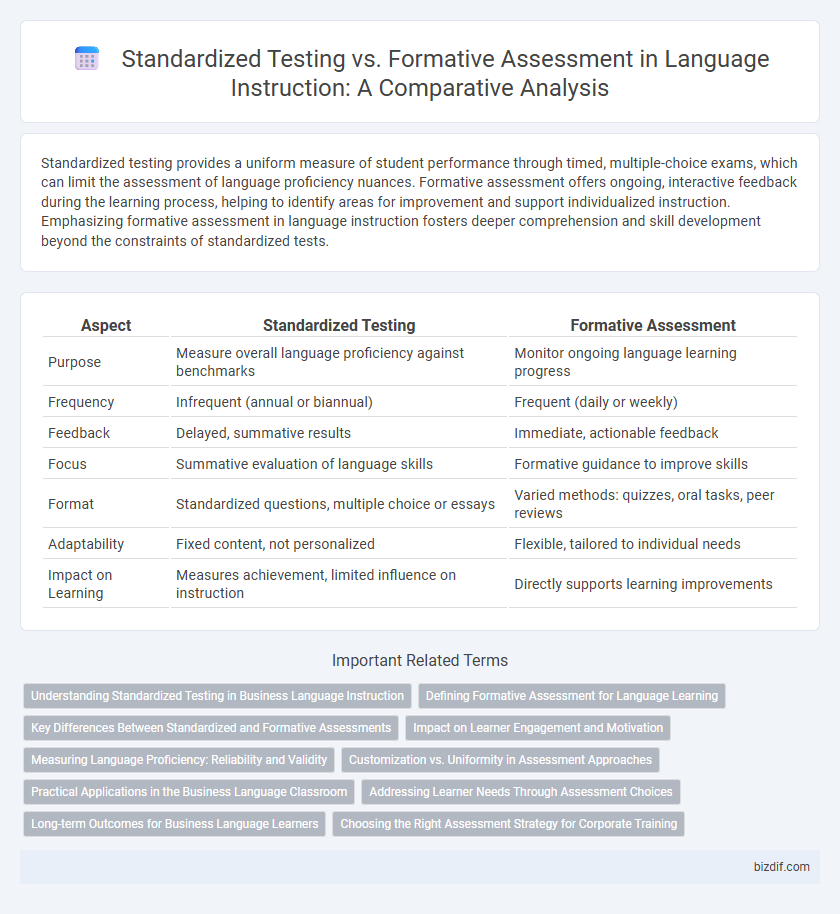Standardized testing provides a uniform measure of student performance through timed, multiple-choice exams, which can limit the assessment of language proficiency nuances. Formative assessment offers ongoing, interactive feedback during the learning process, helping to identify areas for improvement and support individualized instruction. Emphasizing formative assessment in language instruction fosters deeper comprehension and skill development beyond the constraints of standardized tests.
Table of Comparison
| Aspect | Standardized Testing | Formative Assessment |
|---|---|---|
| Purpose | Measure overall language proficiency against benchmarks | Monitor ongoing language learning progress |
| Frequency | Infrequent (annual or biannual) | Frequent (daily or weekly) |
| Feedback | Delayed, summative results | Immediate, actionable feedback |
| Focus | Summative evaluation of language skills | Formative guidance to improve skills |
| Format | Standardized questions, multiple choice or essays | Varied methods: quizzes, oral tasks, peer reviews |
| Adaptability | Fixed content, not personalized | Flexible, tailored to individual needs |
| Impact on Learning | Measures achievement, limited influence on instruction | Directly supports learning improvements |
Understanding Standardized Testing in Business Language Instruction
Standardized testing in business language instruction measures learners' proficiency against uniform criteria, ensuring consistency in evaluating language skills relevant to corporate communication. These tests often focus on grammar, vocabulary, and comprehension through multiple-choice or written formats, providing quantifiable data for benchmarking employee progress. Despite offering clear performance metrics, standardized tests may overlook contextual language use and practical communication skills critical for real-world business interactions.
Defining Formative Assessment for Language Learning
Formative assessment in language learning encompasses continuous, interactive processes that provide immediate feedback to students, enabling real-time adjustments in teaching strategies and learning activities. Unlike standardized testing, which measures language proficiency at fixed points, formative assessments utilize diverse tools such as quizzes, oral presentations, and peer reviews to monitor progress and address specific linguistic challenges. This approach enhances communicative competence by fostering adaptive learning environments tailored to individual student needs and language acquisition stages.
Key Differences Between Standardized and Formative Assessments
Standardized assessments measure student performance against uniform benchmarks, providing quantitative data for comparison across populations and time. Formative assessments offer ongoing, qualitative insights into individual learning progress, allowing educators to tailor instruction in real-time. The key difference lies in standardized tests' summative, high-stakes nature versus formative assessments' continuous, low-stakes feedback role.
Impact on Learner Engagement and Motivation
Standardized testing often limits learner engagement and motivation due to its high-stakes nature and emphasis on rote memorization, which can foster anxiety and reduce intrinsic interest. Formative assessment, characterized by ongoing feedback and adaptive learning strategies, enhances learner motivation by promoting active participation and personalized growth. Research indicates that formative assessments lead to higher engagement levels and improved self-efficacy compared to standardized testing environments.
Measuring Language Proficiency: Reliability and Validity
Standardized testing offers high reliability and validity by providing consistent, objective measures of language proficiency across large populations. Formative assessment, while more flexible and adaptive to individual learner needs, may sacrifice some reliability for richer, context-specific insights. Balancing both approaches ensures comprehensive evaluation by combining standardized metrics with dynamic, ongoing feedback.
Customization vs. Uniformity in Assessment Approaches
Formative assessment prioritizes customization by tailoring feedback and activities to individual learners' strengths and weaknesses, enhancing language skill development through ongoing, adaptive evaluation. In contrast, standardized testing emphasizes uniformity, applying consistent criteria and scoring to all test-takers, which facilitates large-scale comparison but may overlook unique learner needs. The balance between these approaches influences instructional strategies, impacting the effectiveness of language acquisition and learner motivation.
Practical Applications in the Business Language Classroom
Standardized testing in business language classrooms provides measurable benchmarks to assess learners' proficiency in industry-specific terminology and communication skills. Formative assessment allows instructors to tailor feedback and adapt lesson plans, enhancing practical language use for scenarios such as negotiations, presentations, and client interactions. Integrating both methods optimizes language acquisition and prepares students for real-world business environments.
Addressing Learner Needs Through Assessment Choices
Standardized testing provides uniform metrics to evaluate overall student performance but often overlooks individual learner differences and growth. Formative assessment offers ongoing feedback tailored to students' unique needs, promoting personalized learning and timely instructional adjustments. Balancing both assessment types ensures comprehensive insights that address diverse learner profiles effectively.
Long-term Outcomes for Business Language Learners
Standardized testing often measures immediate language proficiency but may not accurately reflect the ongoing development of business communication skills essential for long-term career growth. Formative assessment provides continuous feedback that helps business language learners adapt and improve their practical language use in real-world contexts. Emphasizing formative assessment fosters deeper language retention and enhances professional competence, leading to better long-term outcomes in global business environments.
Choosing the Right Assessment Strategy for Corporate Training
Standardized testing provides consistent metrics to evaluate employee knowledge across an organization, ensuring benchmark compliance and skill validation. Formative assessment enables ongoing feedback and personalized learning adjustments, fostering continuous improvement and engagement during corporate training. Selecting the right assessment strategy depends on training goals, content complexity, and desired outcome, balancing objective measurement with adaptive learning support.
Standardized Testing vs Formative Assessment Infographic

 bizdif.com
bizdif.com